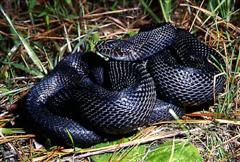Pine Snake - Black
Scientific Name: Pituophis melanoleucus lodingi
Tue, 8th April, 2025 - 5:09 pm GMT
Sponsor Ads:

Alternative Name
Scientific Name: Pituophis melanoleucus lodingiBasic Info
The Black Pine Snake averages about five feet in length, although they can reach up to eight feet. The Black Pine Snake is usually dark colored, either brown or black, with spots along the sides. They have keeled scales and a pointed snout. The rostral scale is larger than average and extends between the internasal scales.
Health
Breeding Female Black Pine Snakes lay a clutch of between four and eight very large eggs. The eggs are laid in the springtime in burrows or under large rocks or logs. The eggs usually hatch between 64 and 79 days. The hatchlings are between twelve and eighteen inches at birth.Habitat
Making its home in pine and oak forests and fields, the Black Pine Snake will often hide in burrows or under rocks.Behavior
The Black Pine Snake is quite rare and is considered an endangered species. Private owners rarely keep them. In the wild, Black Pine Snakes distrust humans, but captive-bred Black Pine Snakes can be fairly docile. They are aggressive, especially in the wild. When threatened, they will vibrate the end of their tail against the ground and make a loud hissing noise. The hissing sound is meant to intimidate the enemy and is usually accompanied by a strike. The vibration of the tail, especially amid dry vegetation, often resembles the sound of a rattlesnake. The Black Pine Snake is primarily diurnal, meaning it is active during the day, however, in warm weather it may shift to nocturnal activity. When the egg is about eight inches down their neck, they press their body against the ground. The pressure of their body against the ground breaks the egg, which they swallow along with the shell. Hen's eggs are a good size for consumption by the Black Pine Snake, and they are capable of robbing a nest of several eggs at once. The only known predator of the Black Pine Snake is man.Origin
Southern United StatesHistory
Originally native throughout Mississippi, Louisiana and Alabama, the Black Pine Snake now only exists in the Washington Park region of Louisiana, three counties in Alabama, and fourteen counties in southern Mississippi. They are an endangered species in Mississippi and a protected non-game species in Alabama. Most of the Black Pine Snakes in existence live in DeSoto National Forest in Mississippi. The current conservation status of the Black Pine Snake is now undetermined as they were once part of the now defunct Category 2 of the U.S. Fish and Wildlife Service. This category, which has been eliminated, was reserved for animals that little information existed on and were therefore not able to be classified as threatened or endangered.Common Foods
The Black Pine Snake feeds primarily on small vertebrates including rabbits, squirrels, and birds. The Black Pine Snake also eats bird eggs, which they swallow whole.Sponsor Ads:
On the ONE day you take your secretary to lunch, your wife will be lunching in the same restaurant. -- Unknown
Pine Snake - Black
Coded by: BGID® | ALL RIGHTS RESERVED Copyright © 2000-2025
Disclaimer | Privacy | Report Errors / Contact | Credits


 President of the United States of America - Real Estate mogul, Pageant owner and now one of the most controversial men in political history.
President of the United States of America - Real Estate mogul, Pageant owner and now one of the most controversial men in political history.  Politician, US Vice President and President of the USA - Joseph Robinette Biden Jr.
Politician, US Vice President and President of the USA - Joseph Robinette Biden Jr.  versus
versus  Russia: 'The Evil Empire'? Are they all that bad or is it just the USA trying to portray Russia as bad because they are a world power with land bigger and a society very different from the USA ideal?
Russia: 'The Evil Empire'? Are they all that bad or is it just the USA trying to portray Russia as bad because they are a world power with land bigger and a society very different from the USA ideal?  Global warming has been in and out as the "latest" hot topic for many years. It is, according to modern scientists, the result of man-made industrial pollutants, clearing forested areas, agriculture, etc. But now they are thinking it started way before the Industrial Revolution...
Global warming has been in and out as the "latest" hot topic for many years. It is, according to modern scientists, the result of man-made industrial pollutants, clearing forested areas, agriculture, etc. But now they are thinking it started way before the Industrial Revolution... 
 Corona virus
Corona virus 
 Users with wide screen monitors can benefit from more content on every page.
Users with wide screen monitors can benefit from more content on every page.